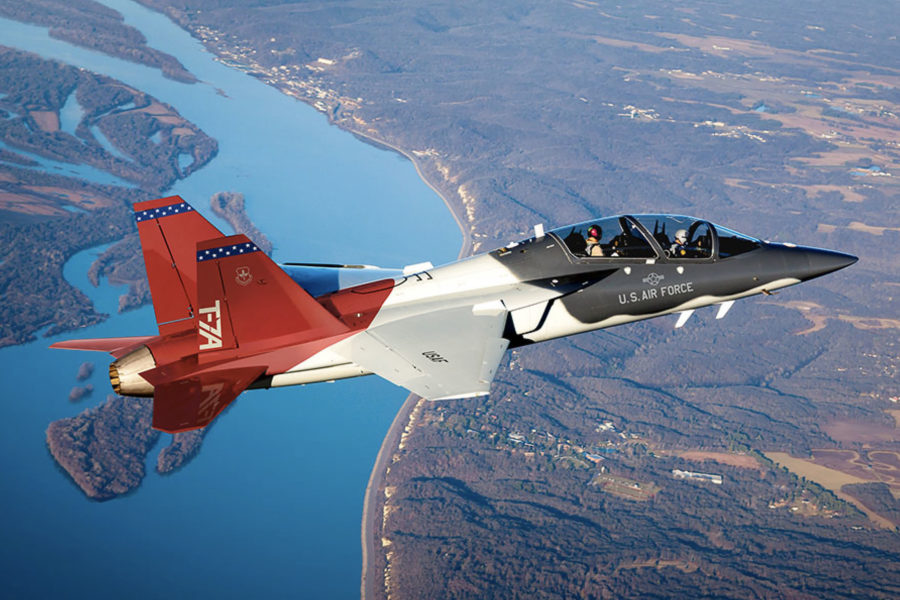The Air Force is seeking “at least 100” and as many as 400 Advanced Tactical Trainer aircraft both to train fighter pilots and to serve as adversary aircraft in training, a role similar to that now performed by the AT-38.
While the Air Force seems likely to be looking at adding to the role of the T-7A, the service did not mention that airplane or its maker, Boeing, in the request for information published Oct. 12.
The service said its RFI is “very similar” to one issued by the Navy for a post-T-45 jet trainer, and to “reduce the burden of crafting a response,” contractors can simply submit the same information as they did to the Navy. The Air Force said it is conducting “market research” to determine what company might be able to respond to the requirement.
Air Education and Training Command, Air Combat Command, and the Life Cycle Management Center did not immediately respond to queries about the RFI. The government wants responses by Nov. 23; it did not specify when it wants to take delivery of the trainer jet.
Air Force leaders have for several years suggested that the T-7 Advanced Jet Trainer could likely be the basis of a companion trainer/aggressor aircraft in the mold of the T-38/AT-38 but have insisted that the new jet must first pass muster as an advanced jet trainer before being adapted to other roles. Former ACC Commander retired Gen. James Holmes said he also could envision the T-7 as the basis for a lower-cost, lightweight export fighter or a homeland defense platform, but the T-7 as yet lacks external hardpoints for weapons and has only an optional aerial refueling system.
The Air Force plans to buy 351 T-7A advanced trainers. If Boeing were to receive the additional work as well, the figure could exceed more than 700 airplanes. In the past, Boeing has suggested a market for the T-7A and variants of at least 1,500 airplanes. Boeing is partnered with Saab of Sweden on the T-7A. Its website says the T-7A has “provisions for growth” to be a light fighter or attack aircraft. Boeing did not return calls by press time.
Lockheed Martin and Korean Aerospace Industries submitted the runner-up in the T-X competition, the T-50A they jointly developed and could potentially partner on for the Advanced Tactical Trainer program as well. That aircraft, plus a combat-capable F-50, have been exported to countries such as the Philippines, Indonesia, Iraq, and Thailand. Air Combat Command has discussed buying or leasing a handful of T-50As or similar aircraft to develop the “Reforge” future basic fighter trainer program in advance of the T-7As arrival in service, now set for 2024. Full operational capability of the T-7A is slated for 2034; in the interim, the Air Force will continue to operate the T-38.
The RFI said the aircraft sought will be used for initial tactical training, “adversary air support,” and as a “tactical fighter surrogate of existing and future” Air Force frontline fighters. The Air Force wants “feasibility, estimated cost, and schedule for at least 100” of these aircraft and as many as 200 more in lots of 50. The service wants a two-seat airplane “plus an option for a single seat” model with options to use the rear seat area for other mission gear.
The airplane sought would have capability for a speed of Mach 0.9 and be able to “replicate current and future fighter aircraft systems” by providing an embedded training environment to build “transferable skills, systems management skills, and decision-making skills” for weapons employment. The jet is to have a large cockpit display and one hardpoint on each wing to carry at least one Air Combat Maneuvering Instrumentation pod or a Combat Air Training Missile. The hardpoints also have to be able to carry an external fuel tank or an electronic attack or countermeasures pod or “other future pods.” Endurance is to be 90 minutes, of which 30 minutes would be “tactical maneuvering.” The jet is to have a ceiling of at least 45,000 feet and have a structural instantaneous G of 7.5, plus a sustained 6G maneuver.
The controls must have a “universal stick and throttle connection” to “enable reconfiguration of the flight controls to mimic Hands on Throttle and Stick of frontline” Air Force fighters.
The jet is to have a “secure open architecture.”
The Air Force is “also interested” in capability to use a helmet-mounted display system, onboard power sufficient to power wing stations and electronic countermeasures pods, and an infrared sensor. It has a preference for an airplane with an automatic ground collision avoidance system (GCAS) and a zero-zero ejection seat, as well as an “engineering analysis or option” for aerial refueling and an infrared search and track system (IRST), among other nice-to-have features.
To go with the jet, the Air Force wants a “smart chair” simulation-like device that can provide a virtual reality for ground-based flight practice.
